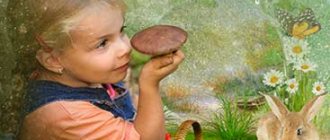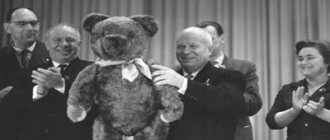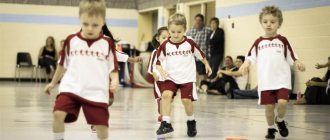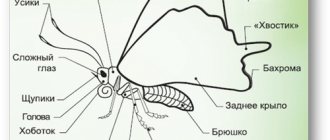Product: Matryoshka made of cardboard and fabric.
Objectives of the lesson: to consolidate knowledge about the studied folk crafts (Dymka, Khokhloma, Gorodets), to introduce students to the history of the nesting doll, to consolidate skills in working with fabric; cultivate a caring attitude towards the material, develop analytical skills.
Planned results: be able to distinguish between the works of Khokhloma, Dymkovo and Gorodets masters, types of images of nesting dolls, learn the sequence of making nesting dolls, be able to work with templates, make an appliqué from fabric, apply cutting skills, mark on fabric, save the material used.
Basic terms and concepts: matryoshka, fabric, wood carver, toy maker, applique.
Resources and equipment: The teacher has: various applications from various materials (paper, fabric, natural materials), examples of matryoshka products, a real matryoshka, fukurama, table “The sequence of making nesting dolls,” types of fabric. Students have: a textbook, a workbook, pieces of fabric, glue, scissors, materials for finishing the product: braid, sequins, beads.
Preliminary work: preparing a table depicting the sequence of making nesting dolls (sequence numbers are hidden).
During the classes
We begin the lesson with messages from students in which they share their impressions of the exhibition that took place in the previous lesson.
Let's check ourselves. Teacher: “In previous lessons, we got acquainted with different types of folk crafts. On the board under numbers are samples of products from various crafts. Tell me what numbers the Dymkovo toy is located under. How did you determine this? Samples of Khokhloma and Gorodets products are also considered.
Let's learn new things. Teacher: “Today a real Russian beauty came to our lesson, a doll with a secret - a nesting doll. Tell me, what is the secret of this toy?” (Matryoshka is a hollow inside, wooden, brightly painted doll in the form of a semi-oval figure into which other similar smaller dolls are inserted). Students read the poem by V. Berestov on page 30 of the textbook and try to explain how they understand it. Teacher: “Usually, 10 “daughters” were placed in nesting dolls. But in museums you can find unique specimens with a large number of internal nesting dolls. Craftsmen from different cities of Russia manage to carve up to 50 “babies” for each painted beauty.” You can ask students to determine what material matryoshka dolls are made from. (Tree). After which the children get acquainted with the professions of a wood carver and a toy maker - they read the text of the textbook on page 32. Then the teacher asks questions: “What do people in these professions do. Tell us about the meaning of toys in ancient times and now.”
Teacher: “We made toys and nesting dolls. The matryoshka doll that our lesson today is dedicated to came to us from Japan. A relative of the Russian nesting doll, the Fukurama folding doll is a cheerful old man. This doll is shaped like an egg. Malyutin S.A. is the artist who painted the first Russian nesting doll. He dressed a cheerful peasant girl in a traditional Russian costume: a scarf, a sundress and an apron, and she held a black rooster in her hands. You all know or have heard the Russian name Matryona. It is believed that it was from this name that the affectionate name “matryoshka” arose.
Look at the nesting dolls (presented on a board or table). What images of nesting dolls do you see? (woman, girl). In addition to matryoshka girls and women, traditionally in Sergiev Posad and Semenov they made matryoshka boys and fathers of the family, sometimes with a curly beard, in a cap and a smart shirt, they could also make nesting dolls in the form of fairy tale and literary heroes. Let’s try to find out how a nesting doll is made.” On the board, the teacher must draw a table in advance “The process of making nesting dolls.” The students' task is to correctly arrange the numbers in accordance with the sequence of actions when creating a nesting doll. The teacher can enter the numbers that students name in the empty cells of the table or stick pre-prepared cards there. In this manual we provide a table with sequential actions and entered numbers. The teacher’s task, when transferring the table to the board, is to swap the actions and leave the left column of the table blank, except for the top line “Action number”.
| Action number. | Name and description of the action. |
| 1. | Choosing a tree (As a rule, this is linden, birch, aspen, larch. The tree must be cut down in early spring or winter so that there is little sap in it. It must be smooth, without knots. The trunk is processed and stored so that the wood is blown . It is important not to overdry the log. The drying period is approximately two to three years. Masters say that the tree should ring). |
| 2. | Turning the shape on a lathe (The smallest nesting doll that does not open is the first to be born. Following it is the lower part (bottom) for the next one. The first nesting dolls were six-seater, maximum eight-seater, and in recent years there have been 35-seater, even 70 -time nesting dolls (a 70-piece Semenov matryoshka doll measuring one meter was demonstrated in Tokyo). The upper part of the second nesting doll is not dried, but is immediately put on the bottom. Due to the fact that the upper part is dried in place, the parts of the nesting doll fit tightly to each other and hold well ). |
| 3. | Preparing the form for painting (the form is sanded and primed). |
| 4. | Painting (Painting gives each matryoshka an individual character. First, the base of the drawing is applied with a pencil. Sometimes the drawing is burned out, and then tinted with watercolors. Then the contours of the mouth, eyes, cheeks are outlined. And then the clothes are drawn on the matryoshka. Usually, when painting, they use gouache, watercolor or acrylic. Each locality has its own canons of painting, its own colors and shapes. Previously, craftswomen painted nesting dolls without a preliminary drawing from a sample. The colors are the same for everyone, but the nesting dolls turn out different, slightly different, and this is their artistic value). |
| 5. | Varnishing (under a layer of transparent shiny varnish the paints acquire a special brightness). |
We do it ourselves. Teacher: “As we have already said, a matryoshka doll is made of wood. But you and I will make a souvenir in an unusual way and from unusual material.”
The preliminary stage before starting practical work is to analyze the product together with the students. Teacher: “Look at the finished product, what material was used to make it?” (Cardboard for the base and pieces of fabric). It is necessary to have a conversation with students about the types of fabric they know (silk, wool, etc.), options for using fabric in everyday life, differences in fabric in appearance, feel, color and quality (thin and thick, transparent and opaque, bright and not very bright).
Additional material. Teacher: “Fabrics are made from fibers. Some fibers, such as cotton and linen, are obtained from plants, while wool fibers are made from animal hair. Man-made fibers are produced using chemicals. There are three methods of joining fibers to make fabric: felting, knitting and weaving. For weaving, a device called a loom is used. The vertical fibers (warp) are held firmly on the loom, while the horizontal fibers (weft) are woven between them to form a lattice appearance.”
The next point of analysis is the methods of working on the craft. Students remember what applique is (a visual technique that is based on gluing parts to a surface). Teacher: “What materials can be used to create an applique?” (The applique can be made from paper, from natural materials, from fabric. The teacher can show different types of appliques from different materials).
The analysis of the product should be completed with a conversation about possible options for its use. Students read how Anya plans to use her craft on page ....
Next, students plan their work with the help of the teacher. 1. Preparation of the matryoshka shape (first cut out the template from the workbook, make the blank out of cardboard based on the cut-out template). 2. Drawing of the main parts of the nesting doll. 3. Creating a matryoshka costume (cut out elements of a matryoshka costume from pieces of fabric: a dress and a scarf). 4. Decorating a matryoshka (for decoration you can use braid, sparkles, beads, gluing them to the beauty’s costume).
Preparation of the matryoshka form. Teacher: “Open the workbooks with the image of the matryoshka template. Let's cut out the image, but first remember the rules for working with scissors (the teacher can use the app). Next, mark the matryoshka doll on cardboard (on the wrong side, remember to save paper). Cut it out. We’ve got the shape of a matryoshka doll that we’ll decorate.”
Drawing of the main parts of a nesting doll. Teacher: “Using a simple pencil, outline the face of the nesting doll (look, it’s round and ruddy), outline the scarf and costume of our heroine.
Making a matryoshka costume. Teacher: “It is necessary to mark the fabric in order to cut out the details of the matryoshka costume. First, mark out the main suit on a piece of fabric of the same color. To do this, you need to draw contours on the fabric; this can be done with a soft pencil, a piece of chalk or soap using a stencil or template. What is the difference between a template and a stencil? (we trace the stencil along the inner contour, and the template along the outer). How to attach a template to fabric? (using safety pins) Don’t forget to save material.” The teacher always demonstrates how to apply contours to fabric. “We'll use the template we cut out from the workbook and trace it onto the fabric. We need to mark the bottom part of the nesting doll and cut out only it, and then glue the resulting part to the template.” On pieces of fabric of other colors, students independently mark the core of the costume and the scarf of the nesting doll, cut out the parts under the supervision of the teacher and paste them onto the template.
Matryoshka doll decoration. In order to decorate our beauty’s costume, you can stick braid and sparkles on it.
Let's summarize. As a result of the lesson, you can hold an exhibition of student work. The analysis of works is carried out according to the following criteria: variability of materials used, brightness, originality, accuracy. Students also answer questions from the textbook.
Homework: Prepare a report about the features of one of the folk crafts that we have not studied, look at illustrations in the textbook with other options for designing a nesting doll and, if desired, do one of them at home with your parents. Place the results of your homework in your achievements folder. Bring to your next lesson some image of a village building.
LiveInternetLiveInternet
Quote from Zoyushka_MARI's message
Read in full In your quotation book or community!
Folk crafts / MATRYOSHKA + my VIDEO
RUSSIAN DOLL
Dear friends! We continue the series of posts about folk crafts... Today we will talk about MATROSHKA... *** First, I bring to your attention my video album with these cute “creatures” .. to a Russian folk melody! And below the video is a brief history of the origin and development of the Russian Matryoshka... *** VIDEO: (mine) Click on the picture and expand to full screen Below the video is a brief history of the origin and development of the Russian Matryoshka...
Matryoshka is one of the famous and beloved Russian souvenirs. The first Russian nesting doll appeared at the end of the 19th century and gained unprecedented recognition as one of the comprehensive images of Russia, a symbol of Russian folk art. The predecessor and prototype of the Russian nesting doll was the figurine of a good-natured bald old man, the Buddhist sage Fukuruma, which contained several more figures, nested one inside the other, imported from the island of Honshu. The Japanese, by the way, claim that an unknown Russian monk was the first to carve such a toy on the island of Honshu.
The Russian wooden detachable doll was called matryoshka. In the pre-revolutionary province, the name Matryona, Matryosha was considered one of the most common Russian names... Subsequently, it became a household name and began to mean a turning split, colorfully painted wooden product... The first Russian nesting doll, turned by Vasily Zvezdochkin and painted by Sergei Malyutin, was eight-seater: a girl with a black rooster was followed by a boy, then a girl again and so on. All the figures were different from each other... The last one, the eighth, depicted a swaddled baby...
Until the end of the 90s of the last century, nesting dolls were turned and painted in the Moscow workshop “Children's Education”, and after its closure - in Sergiev Posad, an ancient toy-making center near Moscow. According to legend, the first “Trinity” toy was carved by the abbot of the Trinity-Sergius Monastery, founded in 1340, Sergius of Radonezh. He personally gave toys to children. Even among the toys of the royal children there were wooden Trinity toys. They were bought in Sergiev Posad, where Russian tsars with their children and household members came on pilgrimage to the Trinity-Sergius Monastery.
In 1900, the Russian nesting doll was exhibited at the World Exhibition in Paris, where it received a medal and world recognition. From the late 18th to early 19th centuries, carved wooden toys have come down to us depicting a peasant girl in a kokoshnik, a dancing man, elegant ladies and hussars. The first nesting dolls, with their shapes and paintings, also capture a motley, varied life: girls in Russian sundresses with baskets, sickles, bouquets of flowers, or in winter sheepskin coats with a shawl on their heads; the bride and groom holding candles in their hands; shepherdess with a pipe; an old man with a thick beard. Sometimes a nesting doll represented a whole family. Matryoshka is a work of both sculpture and painting, it is the image and soul of Russia.
My page on YouTube: MARI_M_Marianna diary Zoyushka MARIE
Technology lesson notes "Matryoshka dolls"
Checking students' readiness for the lesson. Let's check if everything is ready for the lesson? We show me: a textbook, a workbook, pieces of fabric, glue, scissors, finishing materials.Before we get to work, let’s repeat the rules of the working man:
1. Everyone works at their own workplace.
2. Before you start work, prepare your workplace correctly (prepare everything you need for work in advance)
3. Take care of tools, save materials, always think about how to do the job better.
4. Keep your work area tidy while working.
5. Finished work, clean up the workplace quickly and neatly.
6. You need to work together.
-What types of folk crafts did we get acquainted with in previous lessons?
Carrying out test practical work.
Each student reads and completes the assignment (notebook) on page 10.
Choose the correct statements and circle the corresponding number.
1. Khokhloma painting decorates soft toys.
2. The main background color in Khokhloma painting is black.
3. Spinning wheels, bast baskets, salt shakers, and children's chairs are decorated with Gorodets painting.
4. The main background color in Gorodets painting is red.
5. Potters from Dymkovskaya Sloboda make dishes from red clay, pipes and whistles for children.
6. The main background color of the Dymkovo toy is white.
— Today our friends came to our lesson: Anya and Vanya. We will continue to get acquainted with folk crafts, and who we will talk about, you will learn from the riddle that Vanya will tell you:
There are different girlfriends nearby, but they look alike. They are all sitting next to each other, and there is only one toy. Answer: Matryoshka
Matryoshka is a symbol of Russia, a wooden doll with a secret.
The nesting dolls walked along the path,
There were a few of them:
Two Matryonas, three Matryoshkas
And also Matryoshka!
—
Usually 10 daughters were placed in nesting dolls.
But in museums you can find unique specimens with a large number of internal nesting dolls. Craftsmen from different cities of Russia manage to carve up to 50 children of each painted beauty. She is a kind messenger of friendship and love, happiness and prosperity. What do you know about nesting dolls? ( Children's answers)
- I suggest you watch the presentation about our heroine, then answer my questions.
Children watching the presentation.
- Guys, now answer my questions:
1. Where did this beauty come to us from? ( FROM Japan, the doll's name was Fukuruma, he was a good-natured, narrow-eyed old man - the Japanese deity of longevity and happiness.
2. What is the main secret of Matryoshka? (This is a surprise doll)
3. What material are Matryoshka dolls made from ? (made of wood)
4. What types of trees are suitable for making Matryoshka dolls, and why? (These are birch and linden, their wood is soft and light)
5. Which Matryoshka dolls do you know? ( Polkhov - Maidan, Sergievo - Posad, Semenovskaya).
66. How do they differ from each other? (In colors, because in different regions of our Motherland they are painted differently).
- Let's now get acquainted with the professions of people who create such beauty . (Several students read aloud information from the textbook
).
Let's try to find out how Matryoshka is made.
A table “The process of making nesting dolls” has been prepared on the board. The students' task is to correctly arrange the numbers of actions in accordance with the sequence of their implementation.
1. (4) Varnishing
2. (1) Tree selection
3. (3) Preparing the form for painting
4. (2) Turning the shape on a lathe
After correctly arranging the operations for making a nesting doll, the teacher and the children sum up: all operations must be performed in a certain sequence in order for the product to turn out correct and beautiful.
- Guys, what is an applique? (a visual technique that is based on gluing parts to a surface).
-What materials can be used for appliques? ( applique can be made from paper, natural material, fabric)
-What types of fabrics do you know? ( Silk, wool, chintz, felt, etc.)
-What are fabrics made from? ( from fibers
)
Some fibers, such as cotton and linen, are obtained from plants, and some fibers, such as wool, are obtained from animal hair. Man-made fibers are produced using chemicals. For weaving, a device called a loom is used.
As we have already said, a nesting doll is made of wood, but we will make it in an unusual way and from an unusual material.
Look at the product, what material will we use to make the base of the nesting doll ? (cardboard
), for clothes (
pieces of bright fabric).
Now look at the presentation slide, let’s remember what is included in Matryoshka’s outfit? (Children list)
- Now select the types and colors of fabric in which you would dress your Matryoshka.
Children plan their work with the help of the teacher.
Let's draw up a technological map according to which we will manufacture the product:
1. Preparation of materials and tools.
2.Making a matryoshka shape (first cut out a template from a workbook, make a blank out of cardboard based on the cut out template)
3. Draw the main parts of the nesting doll.
4.Creating a matryoshka costume (cut out elements of a matryoshka costume from pieces of fabric: a dress and a headscarf).
5. Decoration of a matryoshka (for decoration you can use braid, sparkles, beads, gluing them to the beauty’s costume).
Note: Map stages appear on the interactive board as you create the map.
-Let's develop criteria for evaluating our product.
During the discussion, children find common criteria for evaluating their work.
1. Variability of materials used.
2. Brightness
3. Originality
4. Accuracy
— What tools will we use in the lesson? (Scissors)
Let's repeat TB when working with scissors.
- Keep your workplace tidy.
- Before work, check the serviceability of the tools.
- Do not use loose scissors.
- Work only with a serviceable tool: well-adjusted and sharpened scissors.
- Use scissors only in your own workplace.
- Watch the movements of the blades while working.
- Place the scissors with the rings facing you.
- Feed the scissors rings forward.
- Don't leave scissors open.
- Store scissors in a case with the blades facing down.
- Don't play with scissors, don't put scissors near your face.
- Use scissors as intended.
- While working, hold the material with your left (right) hand so that your fingers are away from the scissor blade.
-What glue will we use for work?
-Having cut out all the parts, you glue them onto cardboard - the base. When gluing, you must also remember the rules for working with glue.
-Let's play the game “Glue is invisible”
-Why do you think the game is called invisible glue?
-That’s right, because the craft must be clean and properly glued.
— Let's repeat TB when working with glue.
Handle the glue with care. The glue is poisonous.
- Apply glue to the surface of the product only with a brush.
- Do not let glue get on your fingers, face, especially your eyes.
- If glue gets into your eyes, rinse them immediately with plenty of water.
- After finishing work, be sure to wash your hands and hands.
- When working with glue, use a napkin.
- Open printable workbooks.
1. Let’s check if our workplace is organized? (Children checking their workplace).
2. Using the template from your workbook, cut out a matryoshka figure from cardboard.
3. Using the template, cut out the parts of the matryoshka costume from fabric and glue them to the base.
4. Using the template, cut out the head of the matryoshka doll from paper and glue it to the base.
5. Using the template, cut out a circle from paper, draw a face and glue it to the base.
6. Decorate the nesting doll using braid, beads, etc.
Let's do gymnastics for the fingers. The teacher shows the movements.
Fingers stretched out together
Now you need to hook them up.
Which finger is stronger?
Which one of you can squeeze faster?
Children interlock the straightened fingers of both hands (without the thumb) and, without bending, press them tightly together, pinching each finger between the other two. Then they lower their hands and shake them slightly. Repeat the exercise 2-3 times.
-Now you can start making your own applique.
-You can do the work individually or in pairs.
(Children independently choose the type of work)
-The basis for completing your work will be a diagram that shows the parts, their quantity and the correct location of these parts. (textbook p. 31)
(Audio recording “Matryoshka Doll” sounds)
The teacher determines the time for physical education individually based on the performance of the class. Conducted by the teacher.
"Dressy Matryoshkas":
Clap your hands
Friendly nesting dolls. (Clap their hands)
Boots on feet, (Hands on waist, alternately place foot on heel forward)
Matryoshka dolls are stomping. (Stomping feet)
Bend left, right, (Body tilts left - right)
Bow to everyone you know. (Tilts head left and right)
The girls are naughty
Painted dolls.
In your colorful sundresses (Hands to shoulders, body turns right - left)
You look like sisters.
Okay, okay,
Funny nesting dolls. (Clap their hands)
When making crafts, music about nesting dolls is played.
-Check how you did the work according to the highlighted criteria.
Now everyone will come out with their work, and we will see how you coped with the task.
(Children evaluate the work of their comrades, noting mistakes and favorite works.)
(slide)
(Indicate shortcomings, if any.)
-Where can I use this application?
-A gift for family and friends or as a panel.
At the end of the lesson, we have to summarize what we have learned, what new knowledge we have discovered for ourselves. To do this you have to solve a crossword puzzle.
(Children solve the crossword puzzle, then test themselves on the next slide)
-What was difficult when making the product?
-Which stage of the lesson did you find the most interesting? Why?
-What new did you learn in class today?
-What have you learned?
At home, prepare a report about the features of one of the folk crafts that we studied. If desired, together with your parents, make one of the versions of the nesting doll.








